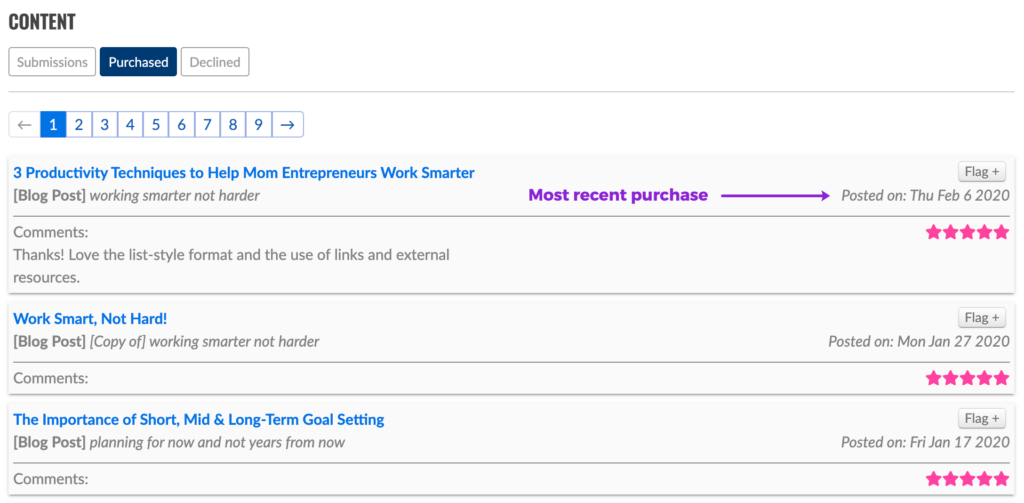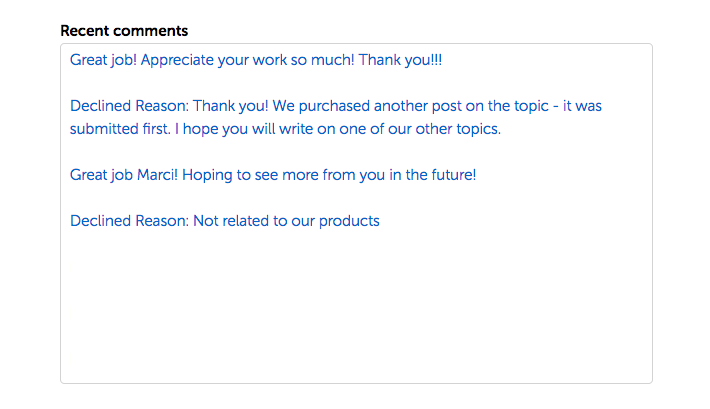By Michelle Halsey, Level 9 Writer — Check out her Freelance Writer Spotlight to learn more.
Are you new to Verblio and getting a feel for how things work around here? Or trying hard to take your Verblio game to the next level?
The help pages are a great place to start, but sometimes we writers need a little extra context. I’ve been here a little more than a year, and as a member of the Writer’s Forum, I’ve seen lots of newer writers go through the same “getting acquainted” process I went through not too long ago…and like them, I’ve learned a lot from those who’ve been writing for Verblio for years.
I’m amazed by what I’ve managed to accomplish here in such a short time. I’ve set and surpassed goals, thrown some hissy fits on the forum, cheered as the staff made several writer-suggested changes, and I’ve made a lot of friends and professional connections. I’ve also learned some pretty amazing stuff about everything from hypoallergenic, cruelty-free down pillows to cleaning up after a crime scene.
Thanks to freelance writing, I always have something interesting to say at dinner parties.
(“What did I do today? Well, first I wrote about vaccinations for kittens. Then I wrote a blog post about secondary pest infestations that occur when a human body decomposes in a home that lacks proper climate control. In Florida. In the summer. How was your day?”)
I’ve gone from an average of $60/week in sales to well above $300, and guess what? I’m lazy. I could easily increase my earnings if I set aside more time to write and put more time into researching topics outside my current comfort zone. But hey, I’m not trying to sell you on Verblio; you’re already here. I just want to make things a little easier for you by sharing the best advice I’ve gleaned from my fellow writers.
Ready to kick butt and start paying those bills? You can jump ahead using the links below, or simply read on to get the whole story. Choose your own adventure!
Taking Advantage of the Forum
Do you want a writer’s thoughts about a particular customer? Need some links to useful writing websites or SEO practices? Do you want to pick the brains of full-time professional bloggers? If you haven’t checked out the forum, you’re missing out on one of Verblio’s biggest assets.
Our online community is a friendly and supportive forum for exchanging ideas, finding inspiration, making connections, and learning about the writing profession. You’ll meet writers from all backgrounds and levels of experience. Staff members—including Verblio’s founders and executives—regularly drop by to make announcements, answer questions, or get the ball rolling on lighthearted topics.

The only rule on the forum is everyone’s required to be respectful of one another, even when we disagree. So if you’ve been turned off by bad behavior and bullying on Reddit forums or Facebook groups, you’ll be pretty happy here!
Choosing the Right Customers
Ask any forum regular and they’ll tell you that newcomers to the platform always want to know how to choose the right requests and the right customers. We’ll get to selecting topics later, but determining customer behavior is the key to being successful here.
Searching for customers
The Jobs page allows you to filter your search by word length, industry, customer name, and keyword. Pretty straightforward stuff, and it’s all outlined in the help pages, too. Familiarize yourself with the search function and results page, and play around with your options. You can search (and sort the page) by keyword, industry, client, and job length category.
Building a customer profile
Now that we’ve addressed the technical stuff, let’s get down to what really matters: How active is the customer, how likely are they to buy our posts, and which ones we should avoid like the plague.
First, get familiar with the layout of the Create Content page. Beyond what you can learn from the contents of the “black box” (containing the customers’ requests), you want to pay attention to the following:
- Available credits and credit renewal
- Active submissions
- Purchases
- Declines
- Additional Information
- Previous comments and reviews
The customer credit system
Verblio’s customers purchase credits, which they then apply to the posts we write. Sometimes, they purchase a whole mess of them at once, while others are on an “autorefresh” schedule: Verblio charges their account on a monthly basis, thus renewing the customer’s credit “allowance.”
If you look above the client’s name, you might see something like this:

For example, a client has “2 posts needed now,” that means they’re able to select and purchase two posts at any time. If that number is zero, the next part of the phrase will tell you when they’ll get more credits, and how many they’ll have to spend.
Customers usually assign topics around the same time their credits renew. Usually. Some will post a ton of topics all at once, even if it would take them months to use all the submitted posts in their queue. (These clients tend to change their minds about wanting these topics after a while, so watch your step here).
Then, there are some customers who will buy extra credits whenever they feel like it so they can snap up particularly awesome posts. We LOVE these clients!
All writing platforms have a strategy, and sometimes we’re stuck doing math (yuck). Fortunately, on Verblio, it’s relatively easy to predict when content might be purchased (or declined) once we understand how the customer buying cycle works.
Client activity (or lack thereof)
Click on “Purchases” to find out when the client last purchased. If it looks like they buy on a regular basis, that’s obviously a plus. If they’ve been racking up credits but haven’t purchased anything in more than two months, trust your gut; three months or more, move on.

If they have a queue (“Submissions” tab) at least three times as long as their available credits—unless you see “scheduled for (date),” which indicates that customers are on the “auto-delivery” program—you might want to find a more active customer.
Some of us write for low-velocity customers because chances are, our content will eventually sell, and there’s often less competition and more time to complete the article. I’ll take the risk if it’s a topic I enjoy, can write without too much effort, and can recycle elsewhere if it dies on the vine.
Be wary of writing time sensitive posts—those that become obsolete after events or holidays—especially for customers who aren’t active; when you do, it’s okay to include [TIME SENSITIVE] in the headline field.
If a customer has a red dot next to their name (on your dashboard), or you see “expires on (date)” at the top of the Create Content page, be very judicious about submitting a post, and only do so if they have more available credits than open topics.
Client comments
There’s a window on the customer’s page with clickable comments that lead to the associated submission. Fewer than half of the customers bother to leave comments, but you’ll get a pretty good idea of their preferences (and attitudes) by scanning their feedback and their previously purchased (or declined) content.

Feedback is a good indicator of how nitpicky a customer is, or what types of articles send them over the moon with sheer joy.
Some of my favorite customers didn’t start out that way. I’ve received a few negative comments on both purchased and declined posts and I adjusted my approach accordingly. One of those customers now specifically requests that I write all of their content, so I can now rely on them purchasing every month.
Star ratings
Sometimes, writers get five-star declines. Other times, folks receive two-star ratings for purchased posts. The star system is mostly for writer egos, or at least that’s what we tell ourselves when we get skunked.
Many customers don’t give reviews or gold stars at all. Don’t take it as a slam against your writing! Just think of all the times you didn’t leave a review for a book you just read, or for that fantastic sushi joint you discovered last weekend.
Most of us agree that dollar signs are all the rating we need, even if we do sniffle a bit when we don’t get extra kudos.
Get the scoop from your Verblio community
Have you written for a client with shocking results? Do you see an erratic mix of comments, from “you’re the best writer ever” to “you should jump off a cliff and die?” You can always search the forum using the customer’s name, or ask fellow writers about their experiences.
Some customers are famous among writers for their behavior (good or bad) but there are always a few of us who succeed even with the most notorious accounts. Are you up for a challenge?
Finding Requests Based on Subject Matter
Verblio has a huge selection of requests from which to choose. If you get tired of cranking out dry, down-the-rabbit-hole posts, you can transition over to easier (or shorter) topics, or try your hand at different industries. Here are some notes about finding requests that you actually want to complete:
General interest requests
These are the most competitive since most everyone can research and write about stuff like “Why Does My Dog Eat Poop?” or “Five Ways to Spruce Up Your Backyard on a Budget.” But they’re also good confidence builders. If your post isn’t selected, chances are you can recycle it to another customer or use it as a sample on your profile.
Industry-specific requests
Sometimes, you’ll find topics that are right up your alley. Yay for you! General topics are very competitive, so if you have professional or personal experience with a particular industry, you could develop a niche here on Verblio.
The staff tries to pair new customers with the right writers, which is why it’s important to fill out those writer surveys we get once in a while. If you find a customer that matches your tone and expertise, feel free to reach out to staff to hook you up.
Stuff that’s over your head… or a worthwhile challenge
If you’re confident in your research skills, you might want to try writing about subjects you know just a little about. A lot of writers here had no clue what blockchain was until they started doing a little digging. Now, a few of those folks know enough about blockchain to have opened up a whole new area of expertise, complete with new writing opportunities.
It’s worthwhile to invest some time in new-to-you subjects. My advice? Read up on the subject, and search out the industry’s go-to publications. Start out with shorter posts until you gain confidence; don’t tackle longer, in-depth articles until you know your stuff. The “fake it ’til you make it” approach isn’t appropriate if the topic requires a lot of dense technical writing and high-level research.
Research, Citation Tips, Plagiarism and Fair Use
Most of our clients want to market themselves as industry thought leaders. They want to promote their blogs as trusted sources of accurate, informative, easy-to-consume content. That means we’ve got to dig up recent data that’s as close to firsthand as possible.
Swimming upstream: Get close to the source
Imagine a salmon traveling from the ocean to a river, then up a series of tributaries until it ends up in the spring-fed creek where it started its life.

That’s how Verblio writers need to approach their research. The closer we get to the source material, the more credible our customers will appear to their audience.
If we find a great article on our client’s subject, does it list sources? Then follow those links. It’s okay, once in a while, to attribute a passage or quote “as reported by (author) in an interview with Joe Schmo in Harvard Review”, especially if that attribution lends credence or context to the data, but all citations should follow AP style, and include hyperlinked text to the source article. (Learn more here.)
It should go without saying that Wikipedia is not considered a credible source. It doesn’t matter if Neil deGrasse Tyson himself went on a coffee bender and edited every astrophysics-related Wikipedia page; if you attribute data to Wikipedia, you’re in for a decline.
Having said that, Wikipedia often has fantastic links to credible sources, and there’s no shame in using the platform as a springboard for inspiration and leads.
Can you think of other outlets you’d avoid citing? If it’s a fluffy, general-audience news site like Huffington Post or Time Magazine (or, God forbid, People) skip it. Keep digging. Major metropolitan newspapers are usually okay (especially if you need a quote on a scientific or statistic-based study that you won’t find in an academic paper) but even still, follow their sources. And try to corroborate everything.
Keep your sources as relevant as possible
Whenever possible, keep it local. If you’re writing for an Australian company, cite Australian sources. Same with North American regions, whenever possible: If you’re writing about wildfire season in southern California, then the Los Angeles Times is a more quotable source than The Washington Post.
Trade associations and newsletters are good resources for industry trends, but be cautious: Never quote or link to a customer’s competitor.
When you’re Googling source material, go to the “Tools” menu and select the categories that bring you results from the past year. While “most recent” studies and polls might be a few years old, you’ll want to avoid referencing anything published more than three or four years ago.
Formatting your quotes and citations
- Learn proper formats for citing websites, books, magazines, and research papers.
- When including links, select the “New Window” option so as not to take viewers away from the customer’s site.
- The blockquote feature (which appears as ” in the editing toolbar) is a useful way to highlight key quotes and points…but don’t overdo it.
- Too many quotes will trigger Verblio’s plagiarism checker, and it just looks lazy. Use a mix of direct quotes and paraphrasing, and make sure the article serves as the customer’s authoritative take on the source material. Regurgitated content is, after all, barf.
- Some customers prefer a “bibliography” of sources at the end of each post. Be sure to include the source’s entire URL if they do. Lean toward the AP style, rather than academic citation formats.
Understatement Alert! Verblio takes plagiarism seriously!
Proper citation is pretty much the best defense against plagiarism. I ripped off that last sentence from one of Verblio’s awesome staff members, almost word for word (shhh).
But seriously, folks, even if you’ve only got the best intentions in mind, you’ll need to familiarize yourself the nuances of plagiarism, because if you’re caught doing it—accidentally or on purpose—you’re breaking the law and putting you, the platform, and its customers in jeopardy. If you’re busted, Verblio will suspend your account, and the muses of creativity will curse you and thousands of generations of your descendants with writer’s block.
When you submit an article, the platform runs a plagiarism checker and alert you to potential issues, but it’s always best to use your own plagiarism checker before you hit that button. Grammarly has one, as do several academic paper auto-editors. And at the end of the day, know that you can’t fully trust the computer to tell you what is and isn’t plagiarism. You can still be suspended for content that passes the plagiarism checker if your content is still simply a broad paraphrase of another article. Which leads me to…
Know the difference: fair use, copyright infringement, and plagiarism
There’s a lot of confusion about what’s considered “fair use,” even though the phrase is bandied about all the time. The long and short of it is that you need to be judicious with the amount of another writer’s work you quote, how you format your citations, and how you put that writer’s ideas into your own words. Citations won’t always cover your butt, and it’s just plain wrong to reword another writer’s ideas and data and pass them off as your own.

A great resource for clearing the waters is this page from Harvard University’s Office of the General Counsel. For more information about proper citations—and all sorts of other good stuff—we absolutely love Purdue Online Writing Lab (OWL).
Adopting a Customer’s Desired Tone
Sometimes the winning difference between two perfectly-composed articles is tone or voice. We see a lot of content rejected because the writers didn’t do their homework on the customer, laying waste to all the research they may have done on the topic itself.
- Read previously purchased content and/or the client’s existing blog material to match a customer’s brand identity.
- Check out the slider bars for the customer’s preferred tone and target audience.
- Don’t use five-dollar words for general audience topics. It’s pretentious, off-putting, and either sends readers away or to Dictionary.com.
- Find out if the customer wants you to write from the first-person perspective. When in doubt, don’t.
The most successful writers study previous submissions. It’s mind-boggling how many customer comments include the phrases, “not in my brand voice,” “too wordy,” or “did you even read our guidelines/topic description/blog?”
Completely missing the mark on client’s preferred tone is at least as bad as submitting a poorly-proofed post. Either can get you blocked by the customer.
Formatting Your Posts: “TL;DR” Isn’t Just a Meme
That means “too long; didn’t read.” I had to ask my niece about that one; she used one of my e-mails as an example.
Our customers know that readers don’t want to deal with huge blocks of text. If a post looks overwhelmingly long, especially when viewed on a smartphone, their eyes will cross and they’ll move on. Format your posts into easy-to-consume, scannable sections.
- Keep each paragraph to 3-4 sentences.
- Learn how to use the correct headers.
- Use a block or two of bullet points, but don’t overdo it.
- Use captivating introductions that give the reader an idea of what’s in store.
- Make sure each post has a readable “flow,” with each section transitioning smoothly to the next.
- Wrap up your post with a conclusion that summarizes the article without being repetitive.
- Promotional posts with a “Contact Us” insert button above the text editing field usually require a strong call to action (CTA) at the end. (Don’t forget to edit the text of the link to make sure it’s grammatically correct!)
Sometimes, copy formatting is a balancing act between readability and the customer’s preferences. You might have an excellent formatting strategy, but your customer might not be SEO-savvy. When in doubt, refer to the customer’s previously purchased or published posts.
How to Write Blog Headlines That Don’t Suck!
For many of us, headlines are the most aggravating part of writing a solid blog post. They need to score SEO points while snagging the reader’s attention. Headline writing is extra fun (gag!) when the client wants us to include specific keyword strings.
There’s no single formula for writing the perfect headline, but there are lots of great articles on the subject. HubSpot is one of our go-to resources for inbound marketing advice, and Coschedule has a headline analyzer that several of us like to use.
Your target headline word-count should be six to nine words, with the correct capitalization and—hello!—be error-free!
Here are a couple Verblio-approved resources:
- How to Write Effective Headlines with CoSchedule’s Headline Analyzer
- We Studied Hundreds of Blog Post Headlines. Here’s What We Learned.
By the way… the automatic headline that appears in the text editor is just a suggestion. You’ll need to change it before you save your draft; just add a space or ellipses until you’re ready to replace it with your final title.
Proofreading Like a Pro
Have you ever seen those sports videos where runners faceplant just before the finish line? Close only counts in horseshoes and hand grenades, so if you want to bomb out as a Verblio writer, go ahead and post that article without thoroughly checking it over for errors.
If you’re all about the follow-through (or the paycheck), here are some tips for “scrubbing” your post for poor grammar, typos, and inappropriate punctuation.
- When you’re finished with your draft, take ten minutes or more to clear your head. I call it “breaking the spell.”
- Read your copy out loud. Some writers have their computers read back their posts via “text-to-speech” features; this might work for you. I personally haven’t found one that reads with the right cadence.
- Run your copy through at least one document checker in addition to the Verblio editor’s “Review” window. Grammarly is the hands-down winner among our writers, followed by the Hemingway Editor. Grammarly’s desktop installation is more thorough, but its Chrome plug-in is very handy.
- Make your corrections, then proof your post one last time before submitting it.
- Don’t forget to proofread your headlines and headers!
Customers will reject otherwise fantastic posts because of one or two typos or glaring grammatical errors, and many won’t read beyond the first goof they find. After all, if you can’t bother to read your content, why should they? We see this time and time again when we check out the comments on declined posts, and customers are entitled to complain. They expect professional copy.
Writing for Foreign English-Speaking Customers
Verblio has quite a few U.K. and Aussie clients, and you might run across a Canadian or two. While we speak the same language, many words have different spellings north of the border, across the pond and Down Under. (Color=colour, favorite=favourite, Starbucks=Tim Horton’s). Punctuation and grammar may differ, as well. Here are some tips for writing in the Queen’s English:
- Install and use the Language Tool Chrome extension. It’s clunky, but it works.
- Use country-specific sources and statistics whenever possible.
- Become familiar with the country’s vernacular. Read a few blog posts published on the client’s site to glean industry-specific terms, and feel free to look up articles and slang guides written for American travelers. Just don’t write like an American tourist! Take care not to create a post that rivals the Crocodile Dundee script. (Crikey, mate. That would be a fair-dinkum cock-up!)
- Don’t forget to use the metric system and local currency.
A note on millennial-speak
We’re seeing a lot of requests for articles targeting the millennial generation. As far as we know, there aren’t any good plug-ins for translating millennial-speak. If online cultural websites can’t help you out, we “hundo p” suggest making like Jane Goodall and studying them in their natural environment. Take along plenty of avocado and toast for ease of acceptance.
Completing Edit Requests: Because Love Ain’t Always Unconditional
Verblio recently added a new system by which customers can easily mark passages with requests for changes. When your post receives an edit request, that usually means the customer likes your work and your style well enough to spend the time to help you dial it in.
Some customers go overboard, asking for entire rewrites that are a complete departure from their original topic description. Sometimes, they ask for additional content that surpasses their official word count category. You can choose to decline some or all of the edits, and then the customer can decide whether or not to purchase the final post.
I see edit requests as an opportunity to better understand the customer’s preferences, and to let them know how well I translate their ideas into the “perfect” (for them, anyway) content. And an edit request is always better than a flat-out decline.
Handling Rejection: Sometimes It’s You, Sometimes It’s Them
If you haven’t read Stephen King’s “On Writing,” you really should. Not only will you become a better writer, you’ll feel a lot better when a customer declines your work. King nearly suffocated under piles of rejection letters before he struck gold with “Carrie.”
You’re going to get rejections. Period. Once you’re really up and running here on Verblio, you’ll probably have a rejection rate of six to ten percent. That number will probably be higher when you’re just starting out.
Don’t worry about it, though. Unless your rejections come with negative comments or your percentage skyrockets out of the stratosphere, you’re actually on the right track if you get a few declines now and then. Here’s why:
Uncharted territory: If you’re unsure about the tone and preferences of a customer that’s new to Verblio, you’re taking a risk when you submit their first post. Good for you for being brave!
Competition makes us better writers: Someone else submitted a post on the same topic, and the customer chose theirs over yours. No problem; study the style and tone of the “winning” post, and try again with the same customer later.
Topic No Longer Needed: Customers change their minds. It doesn’t happen that often, but it’s frustrating when it does. It has nothing to do with your writing.
The Rebound: Recycling Your Posts
If your article expires or is declined, you can find a new home for it with another Verblio customer. If you press the “recycle” symbol next to your post on your dashboard, a suggested customer will appear.
Don’t automatically submit your post to that customer! Personally, I’m always amused by the random pairings. I usually open up a new window and search for customers by industry, then submit the rejected post. Your submission likely won’t match up with their open topics, but with a little finesse, you can make it work.
- Make sure you’ve removed any links or references to the previous customer.
- Make any adjustments necessary to better suit the new customer’s listed preferences.
- Verify that your article’s word count meets or exceeds that of the new customer.
- Take one last shot at proofreading.

Caught Between a Rock and a Hard Place? Contact Staff!
If you’ve ever written for other platforms and attempted to seek staff guidance, you likely felt as if you fell into a canyon where nobody could hear you scream. Before you reach for that flimsy Leatherman knock-off and start hacking away at your writing hand, take heart; Verblio has a team of enthusiastic staff members ready to help. Here’s when it’s appropriate (and encouraged) to reach out to writers@verblio.com:
- You haven’t found a solution in the Help section, or by posting your question to (or searching) the forum (where at least one staff member checks in throughout the day).
- It’s either not appropriate to ask on the forum, or too client-specific.
- The customer’s topic description is too vague, and you need staff to request more information or clarification.
- The customer is requesting a word count outside their account range (The staff might negotiate a one-time word count adjustment or a two-part series).
Sometimes we get tired of staring at a customer’s page, wondering if and when they’ll pull the trigger and buy our posts. We might attempt to telepathically persuade the customers to log on, use their credits, and clear their mile-long queues. What we shouldn’t do is request that the staff pesters our customers to make a move.
Verblio account managers have a system for maintaining customer engagement, but they have no control over when a client will decide to use or renew their credits… no matter how many chickens they sacrifice in Hoodoo rituals. But eventually, most posts sell. If they expire, there’s a good chance you can find another home for yours.
You Won’t Win If You Don’t Play the Game: Tips for Success
Once you’ve read the help pages, become acquainted with Verblio’s platform features, and waded into the forums, the best advice we writers can give you is to set goals and write as much as you can. Read up on inbound marketing and refine your blogging skills. Read other writers’ work and cultivate new clients.
Hearts
Once you earn “preferred writer” status with a few clients, take advantage of the topic proposal feature to give yourself more breathing room to write on your favorite subjects. The exclusive three-day period lets us write without the pressure some of us feel when we’re trying to compete with simultaneous submissions.
Writer’s queue
Try to build up a solid queue, especially if you’re writing for customers with varying credit refresh dates. When articles sell, top off that “future earnings” number. When you have a stockpile of pending articles, you’ll have a more stable income and you’re less anxious about selling articles tomorrow that you only wrote today.
Leveling up
Once you hit Level 4, things really start rolling. Even those of us who are eligible for 1500-word topics rely on 600-word posts for our bread and butter. And just because you’re still at Level 3 doesn’t mean you’re any less talented and skilled than those who are in the double-digits.
Find your own rhythm
Everyone has their own goals, and we all write at our own pace. Don’t be too rough on yourself if you’re not cranking out 5000 words a day, or if it takes a while to master the system. You’ll get the hang of it.
We’ve All Been There…And We’re Here for You! Each of us was new here at one point, and every one of us still needs encouragement and advice now and again. I can’t stress enough the importance of the Verblio community for platform writing success. Use it to your personal and professional advantage. The truth is, if you’ve read this far, you already have; most of what I’ve learned and shared here, as well as my success on this platform, is thanks to my fellow Verblio writers. I’m just paying it forward!




